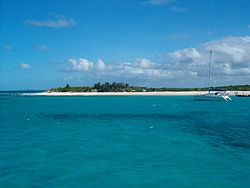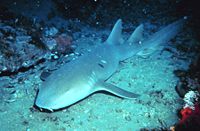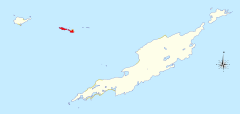Prickly Pear Cays
| Prickly Pear Cays | |
 Prickly Pear Cays | |
|---|---|
| Location | |
| Location: | 18°16’0"N, 63°10’60"W |
| Data | |
| Population: | 0 |
The Prickly Pear Cays, sometimes spelled Prickley Pear Cays, are a small pair of uninhabited islands about six miles north of from Road Bay on the north coast of Anguilla, and forming part of that territory. The cays are divided by a narrow boat channel between Prickly Pear East and Prickly Pear West.[1]
Prickly Pear Cays were classified as 'wildlands' by the "Eastern Caribbean Natural Area Management Programme" (ECNAMP). In addition, Prickly Pear Cays are one of six marine protected areas of Anguilla.[2]
Geography
Along with Dog, Scrub], Little Scrub, Seal, and Sombrero islets, the Prickly Pear Cays are located on the drowned Anguilla Bank.
The cays are characterized by Early Miocene reefal limestone positioned upon Eocene-Oligocene volcanic rocks. These form a section of the active volcanic arc of the Lesser Antilles.[3] The two cays are accessible from Road Bay on the main island's coast, just six miles away.
West Cay is longer than East Cay. North Cay, a six-foot rock outcrop, is situated north of East Cay.[4] There is also a rock outcrop between Prickly Pear Cays and another cay known as Bush Cay, which is separated by a waterway half a mile wide.[1] Another rocky protrusion, known as Flirt Rocks, is situated north of Prickly Pear Cays.[4] Dog Island Channel separates Dog Island from the Prickly Pear Cays.[4]
West Cay is narrow, about three quarters of a mile long and rugged. Its western bay is covered with brush which rises to a height of 25 feet. With rocky coral reefs, it has no easy boat landing facility.[1]
East Cay is about a mile long and quarter of a mile wide. It has sparse vegetation and a sandy shoreline. The east cay also has salt ponds.[5]
Prickly Pear Cays have been designated as a marine park with permanent moorings. There is total ban on coral extraction or shells from underwater and spear fishing is not allowed.[6] The sea is generally calm.[6][7] Prickly Pear Reef is an underwater canyon with ledges and caves whose depth varies from 40 feet to 70 feet and includes an underwater, chimney-like formation.
Geology
The geological formation in both the cays is of laminated calcareous sandstone. The layered stratigraphic formation is inferred to be due to "successive deposits by the tides or overflows from a troubled sea."[8] Over a long period of exposure, these formations have developed a laminated condition with the lamination beds of 1.0 " (25.0 mm) to 3.9 " (100.0 mm) thickness. The strata are disturbed in several sections. They have been assessed as suitable for use in pavements in view of their compact formation.[8]
At West Cay, an old quarry near a good harbour was used for exporting sandstone slabs.[8]
Flora and fauna
Along with certain sections of mainland Anguilla, Prickly Pear Cays were classified as 'wildlands' by ECNAMP in 1980.[9] Many types of plants, birds and reptiles have been recorded in both the cays.[5] Uncontrolled grazing by livestock is permitted in all the vegetation areas.[9]
Plants
Both cays are covered by shrubland. The vegetation is dictated by the thin soil mantle and the presence of limestone cavities. Prickly pear (Opuntia), pope’s head cactus (Melocactus intortus) and |sea grape (Coccoloba uvifera) are the dominant plants. Other common plants are mauby bark (Colubrina arborescens), milky thorn (Sideroxylon obovatum), Guaiacum officinale (|lignum vitae), sage cop (Lantana involucrata), loblolly (Pisonia subcordata), nicker tree (Caesalpinia bonduc) (only on Prickly Pear East), cockspur (Castela erecta) and balsam bush (Croton flavens).[5]
Birds and animals

Nesting birds are a common sight along the rocky coast line.[10][11] The two cays have been identified as an Important Bird Area by BirdLife International because of their breeding seabirds. These include red-billed tropicbirds, brown pelicans, brown boobies, laughing gulls and least terns. Brown noddies and bridled terns also occur. Resident landbirds include Caribbean elaenias and yellow warblers.[12]
Numerous reptile species, such as Anguilla Bank anole and Anguilla Bank ameiva (on East Cay), are seen. Sea turtles also frequent the shores of the cays.[5]
Marine fauna in the reef area include schooling goatfish, crabs, lobsters, barracuda, angelfish, groupers, squirrelfish, butterflyfish, tarpon, mangrove snapper and grunts. Nurse sharks are also seen resting at the sandy bottom under the ledges of the caverns.[5][6]
Tourism
The islands are popular with tourists due to the abundant marine and bird life. There are two restaurants and a bar which are serviced by staff who come in each day from the mainland of Anguilla. Thatch roofed structures provide the ambiance for the vistas of the turquoise blue seas which attract visitors to the cays.[10][13] The East Cay has a landing area which requires careful maneoeuvring.[1] Snorkelling and diving are possible in the East Cay amidst the coral reefs,[10] with several sunken ships in the area.[14]
Outside links
References
- ↑ 1.0 1.1 1.2 1.3 Blunt, Edmund and George: The American coast pilot: containing directions for the principal harbors, capes, and headlands, on the coast of North and part of South America...with the prevailing winds, setting of the currents, &c., and the latitudes and longitudes of the principal harbors and capes; together with tide tables and variation (Edmund and George W. Blunt 1863), page 548
- ↑ Petit, Jérôme; Prudent, Guillaume. Climate change and biodiversity in the European Union overseas entities. IUCN. pp. 70–. ISBN 978-2-8317-1315-1. https://books.google.com/books?id=EzzOgjnhtX0C&pg=PA70. Retrieved 12 February 2011.
- ↑ Ardus, D. A.; Champ, Michael A. (1990). Ocean Resources: Assessment and utilisation. Springer. pp. 28–. ISBN 978-0-7923-0952-9. https://books.google.com/books?id=IBlaJ7o6xY4C&pg=PA28. Retrieved 12 February 2011.
- ↑ 4.0 4.1 4.2 Sailing Directions (enroute): Caribbean Sea. ProStar Publications. January 2004. pp. 120–. ISBN 978-1-57785-567-5. https://books.google.com/books?id=lzdGU9vBTyQC&pg=PA120. Retrieved 12 February 2011.
- ↑ 5.0 5.1 5.2 5.3 5.4 Food and Agriculture Organization of the United Nations (1998). Forestry policies in the Caribbean: Reports of 28 selected countries and territories. Food & Agriculture Org.. pp. 2–. ISBN 978-92-5-104233-5. https://books.google.com/books?id=jgD5quPyKJYC&pg=PA2. Retrieved 10 February 2011.
- ↑ 6.0 6.1 6.2 Cameron, Sarah (1 January 2005). Antigua & Leeward Islands. Footprint Travel Guides. pp. 228–. ISBN 978-1-904777-09-0. https://books.google.com/books?id=VZ_FsS6pY_sC&pg=PA228. Retrieved 10 February 2011.
- ↑ Huber, Joyce; Huber, Jon (15 October 2006). Best Dives of the Caribbean. Hunter Publishing, Inc. pp. 13–. ISBN 978-1-58843-585-9. https://books.google.com/books?id=VPdS7c4uiNYC&pg=PA13. Retrieved 10 February 2011.
- ↑ 8.0 8.1 8.2 Sawkins, James Gay; Wall, Georges Parkes; Barrett, Lucas; Lennox, Arthur; Barrington Brown, Charles (1869). Reports on the geology of Jamaica; or, Part II. of the West Indian survey. London, UK: Longmans, Green, and Co.. p. 259. https://books.google.com/books?id=6V7PAAAAMAAJ&pg=PA259. Retrieved 10 February 2011.
- ↑ 9.0 9.1 World Conservation Monitoring Centre (1992). Nearctic and neotropical. IUCN. pp. 315–. ISBN 978-2-8317-0093-9. https://books.google.com/books?id=PpFj275P1msC&pg=PT315. Retrieved 12 February 2011.
- ↑ 10.0 10.1 10.2 "Prickly Pear Cays". Pricklypearanguilla.com. http://pricklypearanguilla.com/main.htm. Retrieved 10 February 2010.
- ↑ JPM Publications (1 April 2001). Caribbean. Hunter Publishing, Inc. pp. 98–. ISBN 978-2-88452-218-2. https://books.google.com/books?id=rKetrDPLPkoC&pg=PA98. Retrieved 12 February 2011.
- ↑ "Prickly Pear (East and West)". BirdLife data zone: Important Bird Areas. BirdLife International. 2012. http://www.birdlife.org. Retrieved 2012-11-23.
- ↑ "Anguilla Prickly Pear:Lambada". Aquamania adventures. http://www.stmaarten-activities.com/index.php?option=com_content&task=view&id=35&Itemid=36.
- ↑ Caswell, Chris (15 July 2001). Chartering a boat: your guide to a perfect holiday. Sheridan House, Inc.. pp. 152–. ISBN 978-1-57409-111-3. https://books.google.com/books?id=GEMz61vsAv4C&pg=PA152. Retrieved 12 February 2011.
